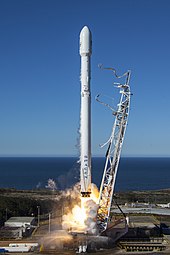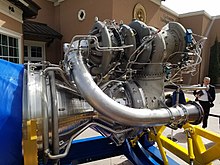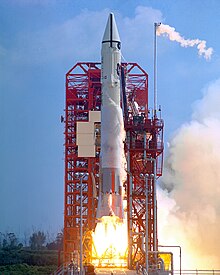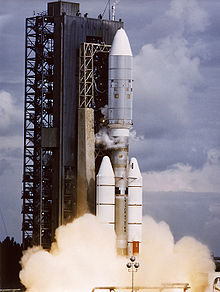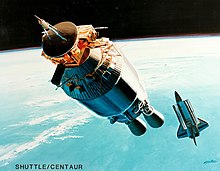Delta IV Heavy liftoff from SLC-6. Delta IV was one of the rockets developed under the initial EELV program.
National Security Space Launch (NSSL) is a program of the United States Air Force (USAF) intended to assure access to space for United States Department of Defense and other United States government payloads.
Started in 1994 as the Evolved Expendable Launch Vehicle (EELV) launch system program, the initial program goal was to make government space launches more affordable and reliable, leading to the development of the Delta IV and Atlas V EELV families. As of 2019, these launch vehicles are the primary methods for launching U.S. military satellites, along with the Falcon 9 developed by SpaceX under NASA's CRS program.
On 1 March 2019, the program changed its name from EELV to
National Security Space Launch (NSSL) to better reflect the changing
nature of launch contracting, including the retirement of STS
and the inclusion of reusable vehicles. The NSSL program launches the
nation's most valuable military satellites; contracts to launch lower
value payloads, such as those of the Space Test Program, are awarded using different methodologies.
History
Initial program goals
The
USAF began the EELV program in 1994, following many years of
government-funded studies into improved systems and architecture. The
intent was to replace legacy vehicles, including Delta II, Atlas II, and Titan IV. EELVs were to reduce costs by being based on standardized fairings, liquid core vehicles, upper stages, and solid rocket boosters. A Standard Payload Interface bus was also proposed as a way to save money and improve efficiency.
Reducing the cost of launches and ensuring national access to
space were the two main goals of the USAF space launch/EELV program.
Some of the reasons why assured access to space is a priority for the
United States are stated in National Presidential Directive Number 40,
which reads:
Access to space through U.S. space transportation capabilities is essential to:
The United States, therefore, must maintain robust, responsive, and resilient U.S. space transportation capabilities to assure access to space.
- place critical United States Government assets and capabilities into space;
- augment space-based capabilities in a timely manner in the event of increased operational needs or minimize disruptions due to on-orbit satellite failures, launch failures, or deliberate actions against U.S. space assets;
- support government and commercial human space flight.
Procurement of EELV boosters for military space launch was to evolve to more closely match commercial practice. The initial bids came from four major defense contractors: Lockheed Martin, Boeing, McDonnell Douglas, and Alliant Techsystems. Each of the bids included a variety of concepts. Boeing initially proposed utilizing the RS-25 Space Shuttle main engine (SSME). When McDonnell Douglas merged with Boeing in 1997, the latter put forth the Delta IV as their EELV proposal. Both the Delta IV and Lockheed Martin's Atlas V eventually entered service.
1990s-2000s
In
October 1998 two initial launch services contracts (known as Buy 1)
were awarded. Along with the award of two development agreements, the
total amount was more than $3 billion.
Boeing was awarded a contract for 19 out of the 28 launches; Lockheed
Martin was awarded a contract for the other 9. Boeing received $1.38
billion, and Lockheed Martin received $650 million for the launches. Boeing and Lockheed Martin were both collectively awarded US$100 million for the final phase of the bid. Boeing developed the Delta IV based around Common Booster Cores (CBC) and the Delta Cryogenic Second Stage, while Lockheed Martin developed the Atlas V based around Common Core Boosters (CCB) and the Centaur upper stage.
In 2003, Boeing was found to be in possession of proprietary documents from Lockheed Martin. The USAF moved 7 launches from Delta IV to Atlas V. To end litigation and competition for a limited market, both companies agreed to form the United Launch Alliance (ULA) joint venture. Each company has a 50% stake in ULA.
2010s
In December 2012, the DoD announced a re-opening of the EELV-class launch vehicle market to competition
while authorizing the USAF to proceed with a block buy of "up to" 36
boosters from ULA. At the same time, another 14 boosters were to be
procured competitively beginning in 2015, with the initial launches to be performed in 2017.
The USAF signed a contract at that time with SpaceX for two
launches in 2014 and 2015 to serve as proving flights to support the
certification process for the Falcon 9 v1.1 and Falcon Heavy. In April 2014, after the launches were contracted, SpaceX sued the United States Air Force, arguing that the RD-180 engines, produced in Russia by the government owned NPO Energomash and used by the Atlas V, violated sanctions against the Russian government. The USAF and SpaceX settled the lawsuit in Jan 2015 by opening up more launches to competitive bidding. The USAF certified the Falcon 9 in May 2015, and in 2016 SpaceX won a contract under the EELV program to launch a GPS Block III satellite payload to MEO.
2018 to 2020s
The
USAF began the process of competitively selecting the next generation
NSSL vehicles in 2018. Announced performance requirements include:
| Orbit description | Apogee (km) x perigee (km) | Inclination (degrees) | Mass to orbit (kg) | Payload category |
|---|---|---|---|---|
| LEO | 926 x 926 | 63.4 | 6,800 | A, B |
| Polar 1 | 830 x 830 | 98.2 | 7,030 | A, B |
| Polar 2 | 830 x 830 | 98.2 | 17,000 | C |
| MEO Direct 1 | 18,200 x 18,200 | 50.0 | 5,330 | A, B |
| MEO Transfer 1 | 20,400 x 1,000 | 55.0 | 4,080 | A, B |
| GTO | 35,786 x 190 | 27.0 | 8,165 | A, B |
| Molniya | 39,200 x 1,200 | 63.4 | 5,220 | A, B |
| GEO 1 | 35,786 x 35,786 | 0.0 | 2,300 | A, B |
| GEO 2 | 35,786 x 35,786 | 0.0 | 6,600 | C |
Category A payloads fit within a 4 m payload envelope, category B payloads fit within a 5 m payload envelope, and category C payloads require an extended 5 m envelope.
The USAF plans to use the next generation NSSL launch vehicles until at least 2030. At least one program was considering follow-on technologies before cancellation in 2012.
Launch vehicles
Currently,
there are four vehicles certified to conduct NSSL launches: Atlas V,
Delta IV Heavy, Falcon 9 and Falcon Heavy. Delta IV Medium was retired
in August 2019. The USAF is currently in the process of soliciting bids
for next-generation launch vehicles, with proposals due by 1 August
2019.
Active
Atlas V-certified
Each Atlas V launch vehicle is based on a Common Core Booster powered by one NPO Energomash RD-180 engine with two combustion chambers and a Centaur upper stage powered by one or two Pratt & Whitney Rocketdyne RL10A-4-2 engines. Up to five Aerojet Rocketdyne Graphite-Epoxy Motor solid rocket boosters can be added to increase vehicle performance, and two diameters of payload fairing are available.
A three-digit (XYZ) naming convention is used for the Atlas V configuration identification. An Atlas V XYZ will have a 4.2- or 5.4-meter diameter payload fairing
(X= 4 or 5), Y solid rocket boosters (0-5), and Z RL-10's on the
Centaur upper stage (1-2). As an example, an Atlas V 551 has a 5.4 m
PLF, 5 SRBs, and 1 RL-10.
Delta IV Heavy-certified
Each Delta IV launch vehicle is based on a Common Booster Core (CBC) powered by a Pratt and Whitney Rocketdyne RS-68 engine and a Delta Cryogenic Second Stage (DCSS) powered by an RL10. Delta IV Heavy is distinguished by two additional CBCs and always flies with a 5 m DCSS and PLF, while Delta IV Medium flew with two or four SRBs on a single CBC.
The DCSS had 4 m diameter and 5 m diameter versions, with matching diameter payload fairings
(PLFs). Delta IV CBCs and DCSSs are integrated horizontally before
being transported to the launchpad. The 4 m diameter DCSS was retired
with the Delta IV Medium after the 22 August 2019 launch of a GPS-IIIA satellite on a Delta IV M+(4,2) with one CBC, two SRBs, and a 4 m diameter DCSS and PLF.
Falcon 9-certified
Falcon 9 liftoff from SLC-4E
The main features of the Falcon 9 in its current Block 5 version include two stages, both powered by LOX and RP-1, with nine Merlin 1D engines on the first stage and one Merlin 1D Vacuum engine on the second stage.
GPS-IIIA USA-289 was the first NSSL-type B5 Falcon 9 launch. The launch occurred on December 23, 2018.
Falcon Heavy-certified
The Falcon Heavy is a heavy-lift rocket developed and produced by SpaceX. It has been certified for the NSSL program after the STP-2
launch completed on 25 June 2019, as confirmed by the commander of the
Air Force Space and Missile Systems Center, Lt. Gen. Thompson.
He clarified: "I certified them to compete last year" and "[o]ne of the
requirements behind certification is to fly three missions." This
requirement has been satisfied by the Falcon Heavy test flight in February 2018, Arabsat-6A
in April 2019, and the STP-2 launch in June 2019. However, Falcon Heavy
has been certified for two Phase 1A reference orbits only and "[i]t's
not certified for all of our most stressing national security space
orbits," Thompson said. Thus, the USAF is working with SpaceX to mature their Falcon Heavy's design.
As of September 2019, it has two manifested classified national security flights for the USAF in 2020 and 2021.
Next generation vehicle competition
As of 2018, a competitive contract award to launch national security spacecraft is underway between ULA, Northrop Grumman Innovation Systems (NGIS), Blue Origin,
and SpaceX. Two providers will be selected to launch spacecraft to a
number of reference orbits. In October 2018, the USAF awarded funding to
ULA, NGIS, and Blue Origin to develop their rockets.
On 12 August 2019, at least three of the four companies submitted
their final bids for the launch services competition. SpaceX bid the
existing Falcon rockets,
while Blue Origin was expected to bid New Glenn, ULA bid Vulcan
Centaur, and NGIS's bid status was not reported. Blue Origin also filed a
pre-award protest of the request for proposal arguing that the
requirements were ambiguous.
New Glenn
Blue Origin was awarded $500 million for development of New Glenn as a potential competitor in future contracts. As of 2019, New Glenn was expected to first launch in 2021.
OmegA
OmegA
is a rocket design by Northrop Grumman Innovation Systems with two main
solid stages, a cryogenic upper stage, and the possibility of strap-on
boosters. The first flight is expected in 2021.


